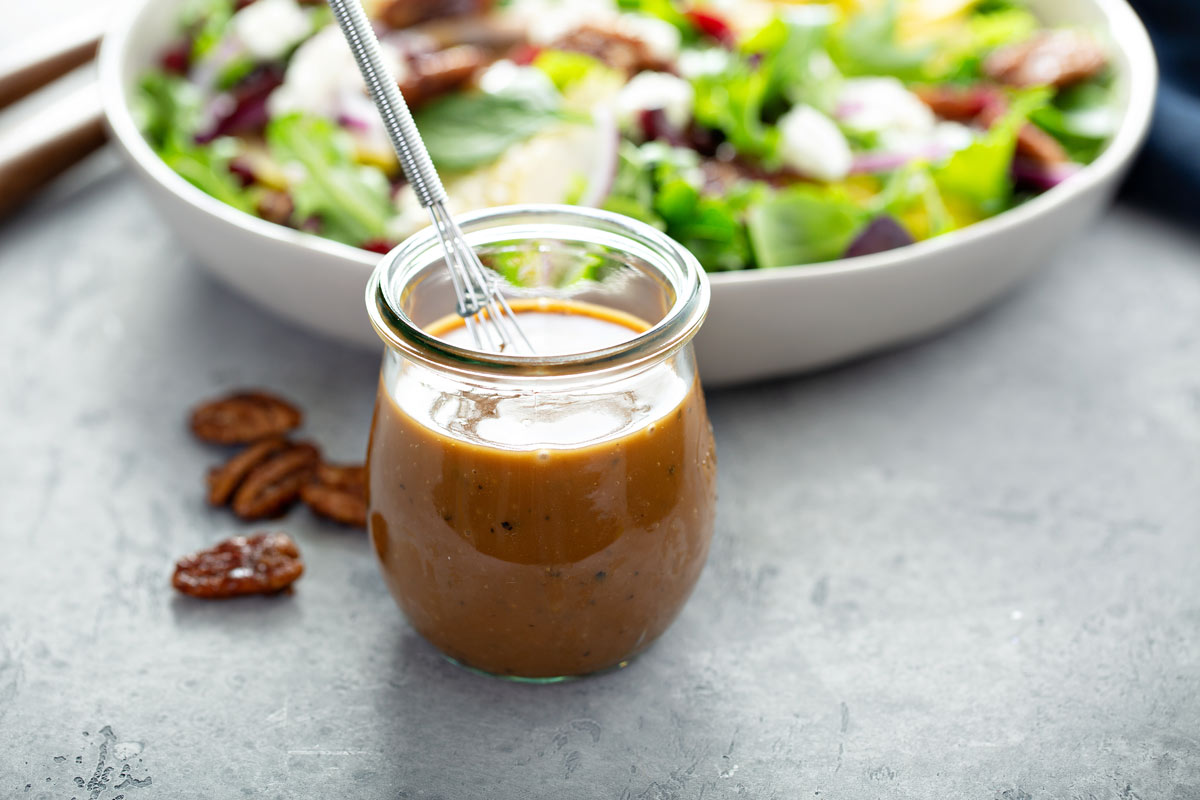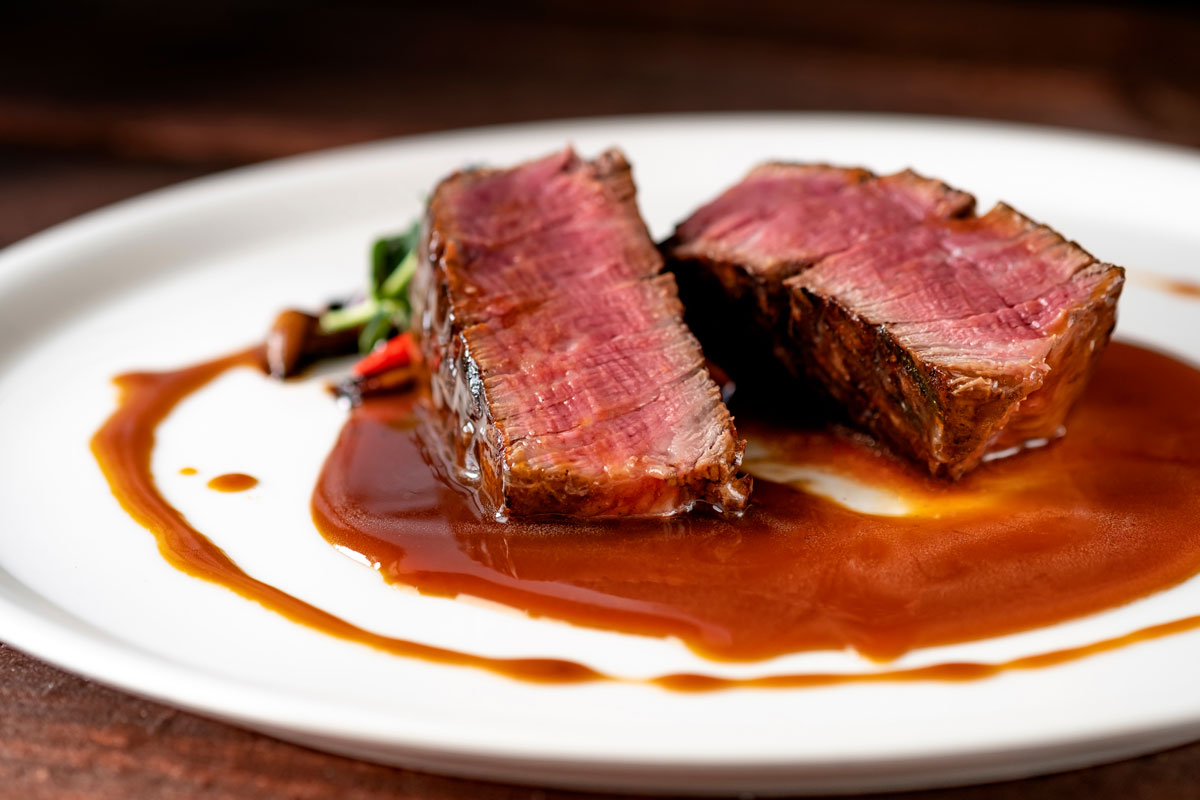Balsamic Vinaigrette and Filet Mignon Alla Modena Recipes, Spotlight on Balsamic Vinegar, Enjoying Aceto Balsamico and The Best-Dressed Salad
Vinegar Essentials, Part III
My travels over the past 20 years introduced me to exquisite vinegars that were not available here, and I’d always load my suitcases with enough bottles to last until my next trip. The judicious addition of a specific type of vinegar can raise the taste profile of a dish in a unique way, adding complex and deep flavors—and that’s why my most recent culinary quest was to bring artisanal vinegars to you and share my vinegar expertise to elevate your cooking as these vinegars have elevated mine. The quintessential vinegar is balsamic, but seeing that word on the label isn’t a guarantee about what’s inside. Here’s what you need to know before you buy, along with two of my favorite recipes.
Balsamic Vinaigrette
 Balsamic Vinaigrette
Balsamic VinaigretteThis vinaigrette must be in your repertoire. It can also be made in a blender or food processor: Pulse all ingredients except the olive oil for a few seconds (the machine can mince the garlic for you), and then, with the machine still running, slowly add the olive oil through the opening in the lid/top until the mixture is blended. (You’ll find that a vinaigrette with honey will quickly emulsify and create a thick dressing.) For deeper flavor, add more vinegar, one teaspoon at a time.
Ingredients
- 1 teaspoon honey
- 2 tablespoons balsamic vinegar, such as Barili Exclusivi Condimento
- 1 teaspoon Dijon mustard
- 1/8 teaspoon fine sea salt
- 1/8 teaspoon finely ground black pepper
- 1 small garlic clove, peeled and minced
- 1/4 cup extra virgin olive oil
Directions
Step 1
In a medium mixing bowl, whisk together the honey, balsamic vinegar, mustard, salt, pepper, and garlic.
Step 2
Add the oil and whisk continuously until the dressing is emulsified.
Yields a scant 1/2 cup
Filet Mignon Alla Modena
 Filet Mignon Alla Modena
Filet Mignon Alla ModenaThis recipe is inspired by the beef dish served at Ristorante Cavallino in Modena, Italy.
Ingredients
- 3 tablespoons all-purpose or white whole-wheat flour
- 1/2 teaspoon each fine sea salt and freshly ground black pepper
- 4 6-ounce filet mignon steaks, about 1-1/2 inches thick
- 2 tablespoons extra virgin olive oil
- 4 tablespoons balsamic vinegar, such as 15 Barili or Barili Exclusivi Condimento
- 1/2 cup beef stock
Directions
Step 1
Combine the flour, salt, and pepper in a pie plate. Heat a cast-iron skillet or other heavy pan large enough to hold the steaks, and then add the olive oil. Once the oil shimmers, dredge both sides of each steak in the flour mixture, shake off any excess, and add to the pan. Sauté for about 4 minutes, and then flip to cook the other side, about 4 minutes more for rare.
Step 2
When the steaks are done to your liking, transfer them to four dinner plates. Deglaze the pan with the balsamic, and then add the stock. Reduce the liquid to a thick sauce.
Step 3
Spoon equal amounts over each steak and serve.
Yields 4 servings.

Spotlight on Balsamic Vinegar
More than Modena on the label
In Italy, the pinnacle of vinegar is aceto balsamico di Modena. Modena, which is the name of both the city and the province, is within northern Italy’s Emilia-Romagna region, known for luscious food—Parmigiano Reggiano cheese, Parma ham, and true balsamic vinegar. It’s my favorite eating region in the country. In fact, my wife, Meghan, and I first toured Modena a few years ago on our honeymoon as part of a food-centric road trip.
True balsamic is made only from Lambrusco and Trebbiano grapes. But “balsamic” has, over the years, become an everyday term, and most people have probably never tasted real balsamic vinegar.
Just as sparkling wines can only be called Champagne if they come from the Champagne region of France, aceto balsamico di Modena can only be called that if the balsamic is completely made within the region. Preserving the tradition of balsamic vinegar and guaranteeing its quality was easier to do until about 50 years ago, when balsamic vinegar making went from being a cottage industry to mass production. These days, there are many products labeled “balsamic,” but the quality varies dramatically. The most exquisite and expensive is called aceto balsamico tradizionale DOP and is made exclusively of the must (all parts of the grapes are used). It must be aged for a minimum of 12 years. Extravecchio balsamic is aged 25 years minimum, which explains why a small bottle can cost hundreds of dollars.
Aceto balsamico di Modena IGP is made only from must and wine vinegar and aged in wooden barrels for at least two months, but there are huge variations in its production. It can be made in an artisanal way, aged in small barrels for as long as three years (or more), or made the industrial way in tremendous barrels and with the bare minimum of must, which results in a product that lacks the quality and taste of a finely crafted vinegar.
The classification condimento all’aceto balsamico di Modena IGP, or “condiment with balsamic vinegar of Modena,” gives producers the freedom to craft a vinegar that goes beyond strict IGP or DOP requirements—that’s what I chose for my new collection. My 15 Barili Condimento “All’Aceto Balsamico di Modena IGP” blends together two prized vinegars: aceto balsamico di Modena IGP Goccia Oro (“Golden Drop”) and a high-quality condimento. It’s named after the number of barrels used in its aging process—the more barrels, the higher the density and the greater its character. I liken it to when vintners create a cuvée, taking wines from various barrels to create a finished product that is greater than the sum of the parts.

Food Pairings
Enjoying aceto balsamico
Because the finest balsamic vinegar is rich and sweet, just a few drops will enhance just about every food, from a risotto to a charcuterie plate to berries and ice cream. I like to pair it with fruitier extra virgin olive oils and mature and fresh cheeses, from Parmigiano Reggiano to mozzarella; cured meats like prosciutto, speck, and salami; tomatoes with a sprinkling of Maldon salt; a composed salad of goat cheese, pine nuts, and honey, or of feta, watermelon, and arugula; cooked vegetables and fish, beef, lamb, and egg dishes; and strawberries, pineapple “carpaccio,” vanilla ice cream, and flourless chocolate cake. Except for the tradizionale, which should never be used in cooking, balsamic vinegar can withstand some heat, but use it judiciously, adding it at the very end of a recipe, such as a risotto, and then top each serving with a few more drops.

Healthy Kitchen Nugget
The best-dressed salad
To maximize taste when making salads, prep your greens by rinsing and drying them in a salad spinner—dressing coats them better when they’re dry, and it won’t be diluted by water clinging to the leaves. Rather than simply pouring vinaigrette over your salad, mix it in with two forks or tongs to really “dress” the greens. Also, keep in mind that vinaigrettes aren’t just for salads; drizzle them over roasted vegetables and cold meats and use them in place of mayonnaise as a sandwich spread. Vinaigrette will keep for up to a week in the fridge—just shake well or whisk as needed before using it.
Get More Recipes In Your Inbox!